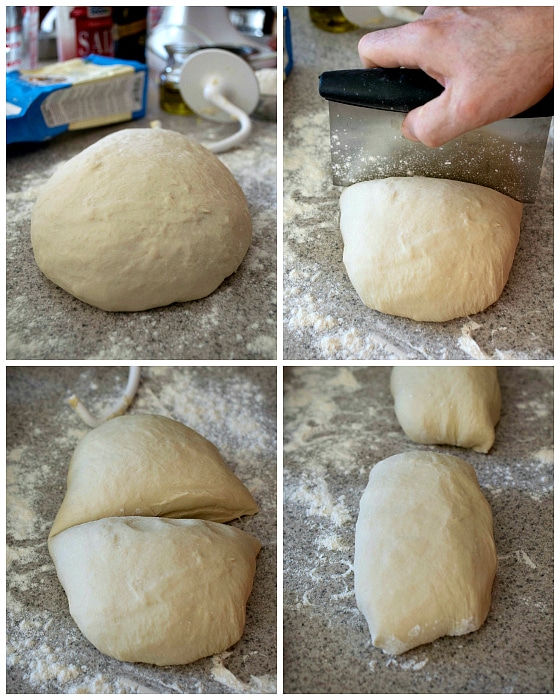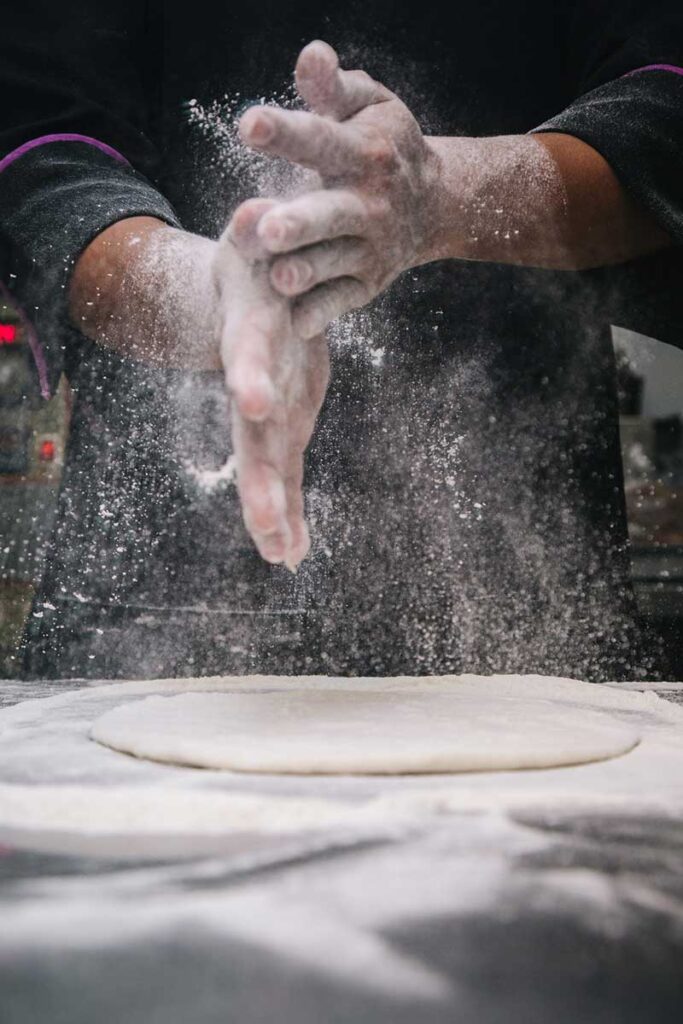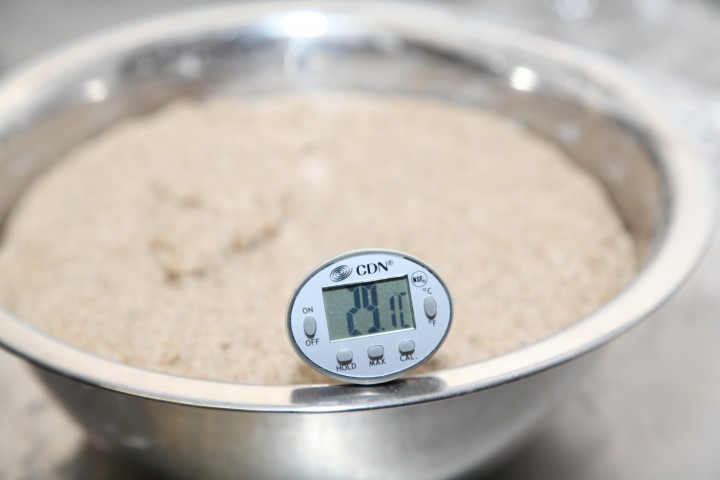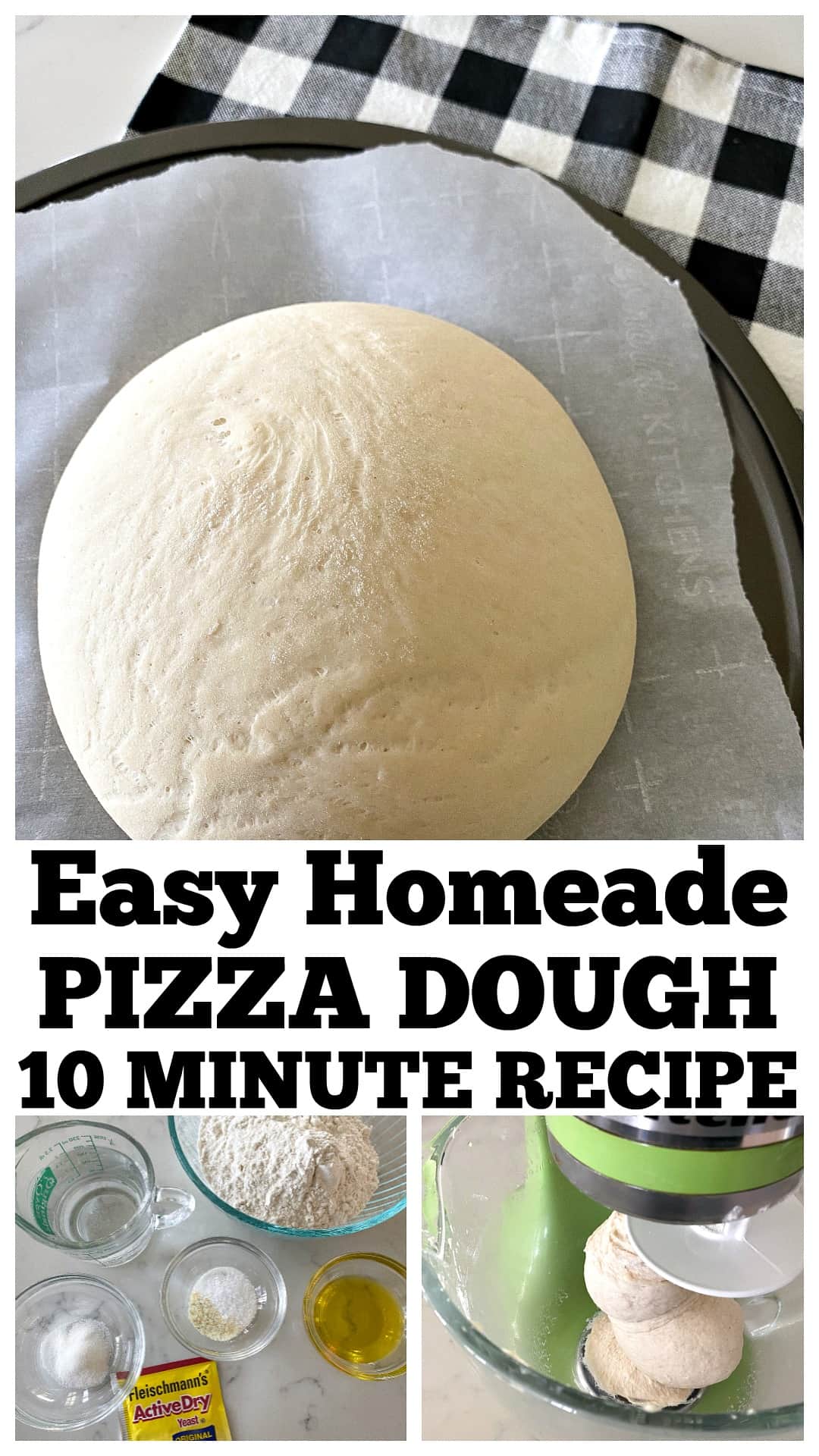Add the olive oil and cold water and knead with the dough hook for 5-7 minutes or 8-10 if kneading by hand. To put it simply when the dough is cold fewer air bubbles escape the dough which results in a thin light and delicious crust.
 Perfect Pizza Dough A Family Feast
Perfect Pizza Dough A Family Feast
Place two-thirds of the water in a large bowl.

Why use cold water for pizza dough. Bring your dough to room temperature. Place two-thirds of the water in a large bowl. With usual pizza making practices you are likely to get good enough gluten even if you dont cool the water.
Before you begin stretching warm up your cold dough for at least 30 minutes at room temperature. Many pizzerias solve this. To make a consistent dough some bakers.
But this stops at 37C around 100F. Each dough was mixed kneaded and set to rise for about 15. The proteins in cold.
In a saucepan or microwave bring the other third of water to boil then add it to the. As Gemignani points out water is pizza doughs second largest ingredient behind flour and its what affects how the dough handles stretches and holds together. Because you are buying yeast by the bottle you know that youre getting a fresh product which means that proofing becomes completely unnecessary.
Kneading will not create resilience either. If its a recipe in which you yeast-leaven the dough its mainly to keep the yeasties happy lukewarm water works best. Hard Water in Pizza Dough.
Pure water is also preferred in the pizza-making process. If water has a high chlorine contact it can affect the culture of the dough. Hot water denatures the proteins in flour.
A 24-hour fermentation will produce a. The symptoms would be worse gluten development. I tested three different pizza doughs at 60 70 and 80 hydration.
Prepare the pizza dough. Why the cold ingredients for pizza dough. Its not a requirement but some times cold water is used in dough to compensate for changes in weather mainly temperature.
The resulting dough is very tender and without resilience. Cold water prevents the premature denaturing of. I started doing that to fix a problem we had during summertime here.
Click to Embiggen. This site is actually the reason I bought the book. We had a real hot humid day in our dough prep area and.
Very hard water is defined as a water that contains a mineral content higher than 180 mgL although not harmful you will know you. In a saucepan or microwave bring the other third of water to boil then add it to the. Prepare the pizza dough.
Yeast are living organisms and like to be treated just like we do given food water and warmth they start to work well. Firstly the yeast in your dough work better to produce gas and rise your dough in a warmer environment. When making yeasted doughs that undergo a long slow fermentation in the refrigerator such as many of our pizza doughs and the dough for our Pita Bread we use ice.
Gluten the protein that makes. Im sure many here have Peter Reinhardts Bread Bakers Apprentice. There are three main reasons why water temperature is important in dough making.
I use Ice-water when we make our dough. The dough should be smooth and elastic and clear. Iron in the water can react with many oxidative dough strengtheners.
Dough doctor -- Various aspects of the water can impact pizza dough in different ways.
We want our dough to emerge from the mixer at 78 F. Above 35C95F and the growth also decreases.
 Making Pizza Dough Make The Real Italian Pizza Dough
Making Pizza Dough Make The Real Italian Pizza Dough
The reason is that you want to slow down the process rather than speeding it up.

What temp water for pizza dough. The best temperature to bake pizza is 500-550F or 250-300C in a home oven and 900F 480C in a wood-fired pizza oven. This pizza dough recipe has a 70 hydration level which is quite high. Pop the dough onto a baking sheet and put it on the shelf above the water.
00 Neapolitan Pizza Flour 100 percent 25 pounds Water 625 percent 15 pounds 6 ounces. Many commercial pizza doughs have a hydration level of only around 55. Heat the oven to 100 degrees.
A long slow rise in the refrigerator takes much longer and typically gives you better flavor and texture. In the official document a room temperature of between 13C55F 33C91F is mentioned as being acceptable. Join the discussion today.
Choosing a temperature means choosing between proofing speed and flavor gluten development. Many pizzerias solve this problem by leaving water out uncovered overnight so. Use a shallow dish and add some boiling water you can also use the oven to boil the water if you wish.
Note that if the room temperature is 72 F water temperature will be 60 F. Read the Water and yeast temperatures for bread and pizza dough discussion from the Chowhound Home Cooking Baking food community. If youre in a rush then there is a temperature window which will have the optimum range for yeast fermentation.
Adjusting the pizza dough proofing temperature The recommended proofing temperature for Neapolitan pizza is room temperature. So what is the best oven temperature for pizza. Defrosting dough first can be useful when you need to reshape the dough for certain menu items such as calzones but other than that there is no need for the dough to be pliable or defrosted before putting it into the oven to bake.
We dont know where the myth came from that dough needs to be brought to room temperature before its baked but its simply not true. This is what creates flavor and texture for your pizza. The reason you start with cold water unlike most other pizza recipes is that you want the dough to be at the perfect temperature for rising at around 23C 73F.
I dont recommend proofing your dough at a higher temperature than room temperature. Mark Bello explains the perfect temperature for water if you are mak. The ideal time for proofing and Neapolitan-style pizza at room temperature is 20-24-hours.
Most people love the taste and texture of a pizza baked in a real pizza oven but not everyone has the luxury of owning one. Store the bottle of IDY in your fridge and use whatever water temp is easiest. I tested three different pizza doughs at 60 70 and 80 hydration.
Pure water is also preferred in the pizza-making process. Because you are buying yeast by the bottle you know that youre getting a fresh product which means that proofing becomes completely unnecessary. Traditionally pizza is baked in a wood-fired brick oven at around 900F 480C.
Temperature water you want to use for your dough. Thats fine if youre using a high-powered or wood-fired oven but for the home oven you want something with a lot more moisture. The Hotter the Better.
So a spot that is just above room temperature is ideal. - 72F room temperature - 71F flour temperature - 22 friction factor 69F water temperature By subtracting the factors were less able to control that contribute to dough temperature we can determine the correct water temperature to use in order to achieve our ideal dough temperature. T he water has to be clean and ideally around 20C 68F when you start baking.
Below 20C68F degrees and the growth is significantly reduced. This is because the longer the pizza dough cooks in the oven the more dry the pizza crust will be. The best oven temperature for homemade pizza is the highest temperature your oven will gofor most people that means 500 to 550 degrees.
This is based on the optimal temperature for. We can counter this affect by using a pizza dough. It is however possible to create virtually the same environment with a regular oven and.
Each dough was mixed kneaded and set to rise for about 15 hours at room temperature before being transferred to the refrigerator for an additional 23 hours cold-ferment. You get the best pizza if you bake it at a really high temperature. And yes freezer to.
Higher temperatures say 80-90 f will get you a fast rise but less flavor and gluten is not as well developed. For pizza baking water with a pH of slightly lower than 7 is preferred. If water has a high chlorine contact it can affect the culture of the dough.
The high levels of humidity will cause the dough to rise in a similar way to when done outside the oven. IDY is highly tolerant of just about any sub 100 deg.
Ingredients200 grams all purpose flour12 tsp salt12 tsp sugar1 tsp dry yeast3 tsp olive oil125 ml waterthis ingredients can make small size pizza doughin. This is the temperature of the dough after going through the mixing process.
 The Best Cold Fermented Pizza Dough Recipe The Pizza Heaven
The Best Cold Fermented Pizza Dough Recipe The Pizza Heaven
On low speed with the paddle attachment stir in the oil and the cold water until the flour is all absorbed.

Can you make pizza dough with cold water. Place two-thirds of the water in a large bowl. The symptoms would be worse gluten development. In a 2 cup measure fill to 1 ¾ full with the ice cold water then bring up to two cups with the ¼ cup of the oil.
With usual pizza making practices you are likely to get good enough gluten even if you dont cool the water and the logistics of cold water are a PITA. You have to make your sponge with room temp water though only the water in the flour can be so cold. An even faster method of defrosting pizza dough is thawing it in a water bath.
78F is considered an ideal temperature. Prepare the pizza dough. Using carbonated water aka club soda or fizzy water will produce a crispier crust cracker like if cooked at high temperatures over 500 F.
Remove the dough from the freezer but leave it in the plastic freezer bag. In a saucepan or microwave bring the other third of water to boil then add it to the cold water in the bowl. Its not a requirement but some times cold water is used in dough to compensate for changes in weather mainly temperature.
Bottom line is I have had horrible results so far and my dough has failed miserably. To make a consistent dough some bakers look at final dough temperature. You can use a warm or cold water bath and you will end up with a soft stretchy dough.
Making dough invokes a lot of chemistry so best to break out the old text books to understand the relationships between cold water vs warmer water adding sugar vs none. For example if I want to make a cold fermented dough that will last a few weeks in the refrigerator I would use a water temperature of in the 40s degrees F. The last time I tried my dough didnt rise after three days of proofing in the fridge then 4 hours at room temperature-NO size increase whatsoever.
Stir together the flour salt and instant yeast in in the bowl of an electric mixer. Turn the mixer on low and slowly but steadily add in the full two cups of the liquid. A warm water bath will thaw faster but you should be careful not to cook the dough accidentally.
Ive read that you should use cold water 40 degrees and you should also refrigerate your flour prior to mixing.